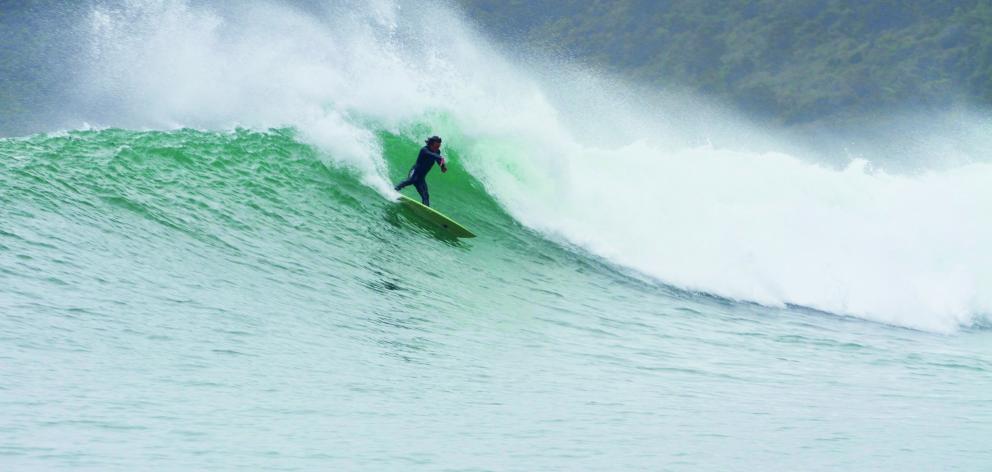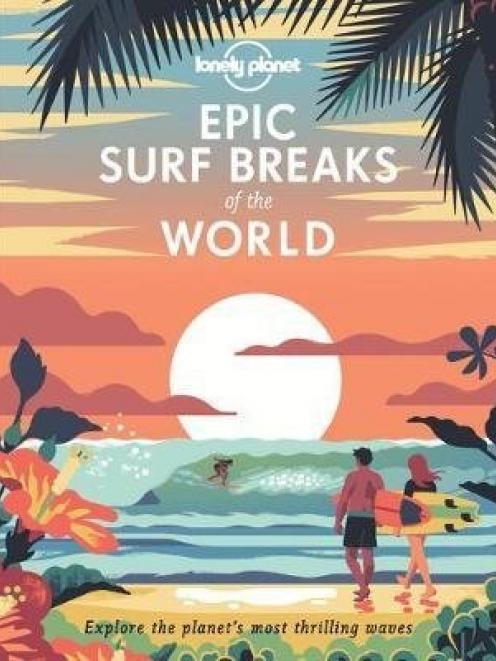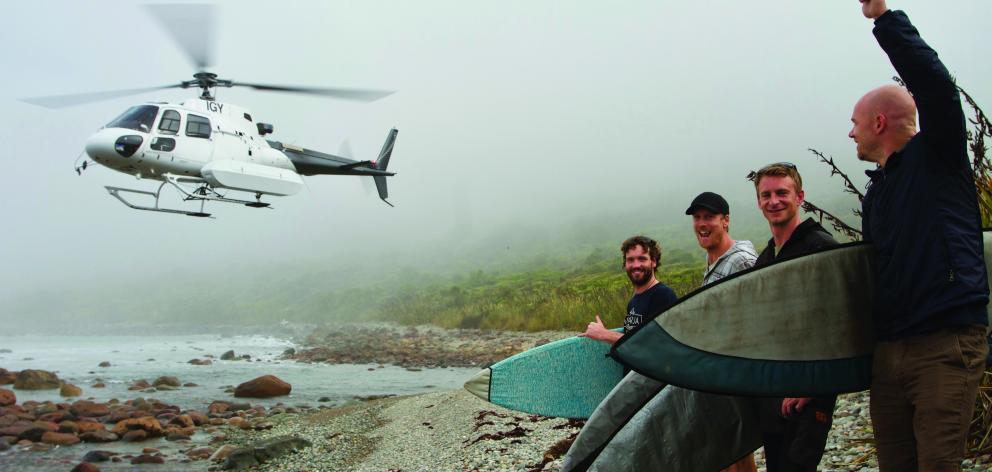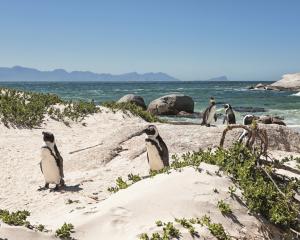

I was in a large bay facing the Tasman Sea, where a wide and gentle river emerged from the forest and emptied into the salt water. It was the sort of melting pot where apex predators love to dine. The beach itself was an epically long stretch of fine sand long enough, in fact, to land a small plane, as we had the evening before. At the far end of the beach, sand gave way to a garden of tide pools. Beyond the rock pools, I was told, there was a wave. But, as I said, this wasn’t a surf trip.
I was travelling around the world with my non-surfing fiancee. Sure, I had rented a board and caught a few waves in places like Raglan and Balis Bukit peninsula during our journey, but these sessions were more obligatory, a little bit like having a pint of Guinness in Dublin. In Fiordland, we were in search of a travel experience where a guidebook and our gadgets were useless. It was one of those ideas inspired by the most random of tips, about a place that you have to see to believe, that almost shouldn’t exist in a world where the word undiscovered is an endangered species. However, the tip did come from a surfer, perhaps I should have known.
Fiordland is New Zealand’s largest national park. Its claim to fame is Milford Sound, one of the country’s most visited natural wonders. But beyond the well-worn tourist circuit is a rugged and vast landscape with little more than a few leftover settlers, many of whom moved into the area in the 1950s and ’60s, in search of a new way of life. They built rustic hunting cabins and, with permission from the government, began living off the land. Anne and Mitch Mitchell did just that in the late 60s, and even went on to raise their three children here. Kelley, Grant and Warrick spent most of their childhood in Fiordland, learning to fish, hunt and dress a red deer by the time they were teenagers. Once the children had grown, the Mitchells stopped living in Fiordland full time, but returned often as stewards of the land. Warrick, in particular, made it his mission to carry on his family’s legacy here, and eventually set up Awarua Guides, named for the river that flows right by the old hunting cabin. Hosting others here allows Warrick to essentially share the Fiordland lifestyle with anyone looking for a wild and immersive experience. This is exactly what my fiancee and I came for. Warrick had no idea he would eventually be specialising in surf trips.

The following morning, I was in a wetsuit again. Only this time, carrying a 7ft surfboard under my arm. I vaguely remember mentioning waves the night before, but more in a ‘so, you get some good waves out here, eh?’ sort of way than in a ‘lets go surfing’ way. Warrick, of course, heard the latter. And he didn’t seem at all concerned with my abilities — we were going surfing.
Never missing an opportunity to stock the fridge, Warrick whipped a fishing rod into the river as we walked towards the point. As I hopped from rock to rock, I looked out to sea nervously, trying to get a sense of the size. Then, with eyes back on the rocks, I stopped in my tracks. Two penguins waddled slowly past me.
Wading out through the kelp, I finally had a clear view of a shockingly good A-frame about 46m in front of me. It was head high, but the water was glassy and the takeoff looked gentle. Beyond the kelp, we began to paddle out. Within minutes, Warrick had popped up on a right-hander. After the drop, all I could see from behind the wave was the spray of his cutbacks at the lip, one after another.
Warrick is one of those rare watermen for whom it wasn’t a lifetime of surfing that taught him about the ocean; it was the ocean that taught him how to surf. From a young age, he could read tides and currents well enough to harvest whatever bounty his family needed from the sea. He fished, went diving and played in the ocean constantly, sometimes riding waves in his canoe. He didn’t even own an actual surfboard until he was a teenager. But the minute he took it out on to the waves, he and the board were one. His infectious enthusiasm and confidence eventually coaxed me on to a wave of my own. After making the drop, I prematurely bailed for fear of riding into the rocks.

Warrick later told me how a surf guidebook called The South Seas described Fiordland as the the last frontier — an undiscovered region that surfers don’t know anything about. This, of course, amused Warrick, as he’d been surfing waves up and down the Fiordland coast for a decade.
After our session, my return trip to the cabin felt somehow different than the walk out. As time passes in Fiordland, perspective shifts dramatically. The initial rawness, the overwhelming onslaught of creatures, biting and buzzing, slimy and odd-looking, underfoot, underwater, and flying overhead, made us a little edgy. But then we began to see sustenance and harvest, and settled into the rhythm of living off the land. Hopping from slimy rock to slimy rock, I thought about which seaweeds were edible. Within 24 hours, my fiancee and I had truly settled into the magic of Fiordland, snacking on mussels we caught ourselves, feasting on lobster and venison harvested within a mile of the table we sat at, happily drinking our cans of Speights through the mesh of our head-nets.
Two years after we visited Awarua Fiordland, Red Bull dropped pro surfers Cooper Chapman, Jackson Coffey and Jordy Lawler off on Warrick’s doorstep and, with his help, they captured several killer sessions in video clips titled Surfing’s Middle-Earth. Warrick says he now hosts over a dozen groups of surfers a year, including quite a few pros, and teams such as O’Neill, Billabong and Yeti. The most recent edition of The South Seas not only includes the Awarua area, but several of Warrick’s photos from these sessions.
Interestingly, most people who come here these days have the opposite experience I did, they come for the surf and end up immersed in a masterclass in extreme foraging. Awarua leaves an impression that has become lore in the surf world. Now I’m just dying to get back for an actual surf trip.
 Karitane has a heavy and hollow right-hand point break. PHOTO: GERARD O’BRIEN
Orientation
Karitane has a heavy and hollow right-hand point break. PHOTO: GERARD O’BRIEN
Orientation

- Getting there: The Awarua Guides hunting cabin is accessed via helicopter from Glenorchy, near Queenstown.
- Where to stay: The best way to experience and surf this part of Fiordland is riding shotgun with Warrick Mitchell. An Awarua Guides adventure (awaruaguides.com) includes a flight from Glenorchy, delicious meals and a comfy bed, either in the hunting cabin or one of his surf safari tents.
- Type of wave: Deep-water A-frame reef break, with left-and righthanders.
- Best conditions: The Austral autumn, into early winter, is most consistent; mid-winter is cold, but surprisingly good.
- Nearest town: Queenstown is less than 80km away as the crow flies or a 15-minute helicopter ride.
- Things to know: Warrick is as much a teacher as he is a host, inviting guests to go lunging for lobster and gut fish.
The South Island swell
- Golden Bay: For a truly wild, windswept experience without the menace of huge cold waves, make the stunning hike out to Wharariki Beach on the very northern tip of the South Island. The Golden Bay area is a rural peninsula culminating in a conservation area full of trails, wild beaches and inlets. It requires a 20-minute hike to reach Wharariki Beach, adding to its remote feel, and a surfable swell is far from guaranteed. Nonetheless, the setting alone makes it a popular spot. The trail winds over hills and dunes, before delivering you to a massive beach with dramatic rock formations jutting up out of the sand and the sea. And if you’re lucky, one of the several peaks along this beach break will have enough shape to ride a few punchy, beginner-friendly waves. Nearest town: Nelson
- Otago coast: Dunedin is the second largest city on New Zealand’s South Island, with a university that gives it a young and fun vibe. The nearby surf, however, is a more serious matter. Diehards flock to what is known as the Otago coast for the massive south swells that roll through in winter. Surfers here share the breaks with yellow-eyed penguins, sea lions and, of course, great whites, but the variety makes it a popular spot even in summer. Some 45km north of town is a heavy and hollow right-hand point break, Karitane, that sits right in front of the mouth of the Waikouaiti River. About halfway between Karitane and Dunedin is Murderers Bay. Don’t let the name scare you: the fast right-hand barrel breaks at manageable size, but it needs just the right conditions to turn on. Further south, Papatowai is known for its Mavericks-esque big waves and draws big-wave surfers from all over. Nearest town: Dunedin
- Kaikoura: The stretch of coastline around Kaikoura is perhaps what Fiordland would look and feel like if it had roads and towns. Some 2 hours north of Christchurch, on the South Island’s east coast, it is by no means remote. It is, however, extremely raw — a place that’s rich with sea life, large untamed swell and massive ocean mammals. South from the tiny town of Kaikoura, lie a dozen or so of the South Island’s best breaks. Perhaps the most popular is the right- hand point break north of a town called Mangamaunu, which fires often and at a manageable size, breaking into a boulder beach framed by lush mountains. A more serious swell can be found just a few clicks south at Kahutara. This is also a right-hand point break, but a much heavier one that comes into its own in the colder months, and is well over head-high. Nearest town: Kaikoura












